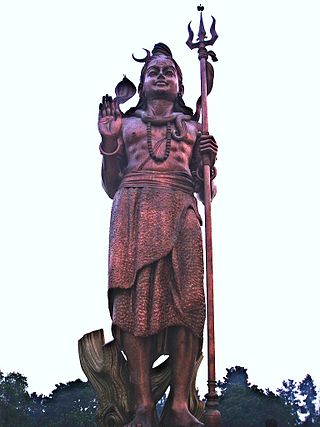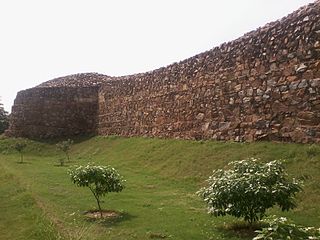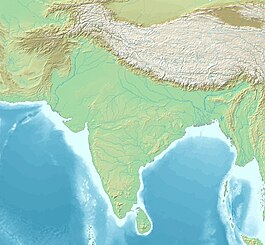
Ibrahim Khan Lodi was the last Sultan of the Delhi Sultanate, who became Sultan in 1517 after the death of his father Sikandar Khan. He was the last ruler of the Lodi dynasty, reigning for nine years until 1526, when he was defeated and killed at the Battle of Panipat by Babur's invading army, giving way to the emergence of the Mughal Empire in India.

Sangram Singh I, commonly known as Rana Sanga, was the Rana of Mewar from 1508 to 1528 CE. A member of the Sisodia dynasty, he controlled parts of present-day Rajasthan, Gujarat and Madhya Pradesh with his capital at Chittor. His reign was admired by several of his contemporaries, including the first Mughal Emperor Babur, who described him as the "greatest Indian ruler" of that time. The Mughal historian Abd al-Qadir Badayuni called Sanga the bravest of all Rajputs along with Prithviraj Chauhan also known as Rai Pithaura.

Sher Shah Suri, also known by his title Sultan Adil, was the ruler of Bihar from 1530 to 1540, and Sultan of Hindustan from 1540 until his death in 1545. He defeated the Mughal Empire, founding the Sur Empire and establishing his rule in Delhi. The influence of his innovations and reforms extended far beyond his brief reign. During his time in power, he remained undefeated in battle and was renowned as one of the most skillful Afghan generals in history. By the end of his reign, his empire covered nearly all of Northern India.

Sikandar Khan Lodi, born Nizam Khan, was Sultan of the Delhi Sultanate between 1489 and 1517. He became ruler of the Lodi dynasty after the death of his father Bahlul Khan Lodi in July 1489. The second and most successful ruler of the Lodi dynasty of the Delhi sultanate, he was also a poet of the Persian language and prepared a diwan of 9000 verses. He made an effort to recover the lost territories which once were a part of the Delhi Sultanate and was able to expand the territory controlled by the Lodi Dynasty.

The Lodi dynasty was an Afghan royal family that ruled Sultanate of Delhi from 1451 to 1526. It was the fifth and final dynasty of the Delhi Sultanate, and was founded by Bahlol Lodi when he replaced the Sayyid dynasty.

Tomar is a clan name, some members of which ruled parts of North India at different times. They are Rajputs and claim Chandravanshi descent.

Lal Kot or Qila Rai Pithora is a fortified complex in present-day Delhi, which includes the Qutb Minar complex. It was constructed in the reign of Rajput Tomar ruler Anangpal Tomar between c. 1052 - c.1060 CE. It is termed as the "First city of Delhi". Remains of the fort walls are scattered across South Delhi, visible in present Saket, Mehrauli around Qutb complex, Sanjay Van, Kishangarh and Vasant Kunj areas.

The Fort of Gwalior or the Gwalior Fort is a defence hill fort in Gwalior, India. Mughal Emperor Babur called it the "pearl amongst the fortresses of Hind" because of its impregnability and magnificence and it has also been nicknamed the Gibraltar of India. The history of the fort goes back to the 5th century or perhaps to a period still earlier. The old name of the hill as recorded in ancient Sanskrit inscriptions is Gopgiri. The current structure of the fort has existed at least since the 8th century, and the inscriptions and monuments found within what is now the fort campus indicate that it may have existed as early as the beginning of the 6th century, making it one of India's oldest defence fort still in existence. The modern-day fort, embodying a defensive structure and two palaces was built by the Tomar Rajput ruler Man Singh Tomar. It has witnessed the varying fortunes of the Guptas, the Hunas, the Pratiharas, the Kachhwahas, the Tomaras, the Pathans, the Surs, the Mughals, the English, the Jats, and the Marathas represented by the powerful Scindia dynasty who have left their landmarks in the various monuments which are still preserved.

Hinduism is the majority religion in Delhi, India. According to the 2011 Census of India, the National Capital Territory of Delhi has 13,712,100 Hindus, who form 81.68% of the population. Hinduism can be extensively seen in culture and history of Delhi and was established by Hindu Tomara king, Anangpala. Though, the Hindus have seen some decline in the Delhi Sultanate and Mughal Empire, due to conversions and persecution. Delhi is also home to many Hindu temple and ashrams. There are more than 590 registered temples in Delhi, out of which Kalka, Birla, Akshardham and ISKCON Temple are the most visited.

The Jaunpur Sultanate was a late medieval Indian Muslim state which ruled over much of what is now the states of Uttar Pradesh and Bihar between 1394 and 1494. It was founded in 1394 by Khwajah-i-Jahan Malik Sarwar, an eunuch slave and former wazir of Sultan Nasiruddin Muhammad Shah IV Tughluq, amidst the disintegration of the Delhi Sultanate's Tughlaq dynasty. Centred in Jaunpur, the Sultanate extended authority over a large part of the Ganges-Yamuna Doab. It reached its greatest height under the rule of Sultan Ibrahim Shah, who also vastly contributed to the development of Islamic education in the Sultanate. In 1494, Sultan Hussain Shah Sharqi was defeated by the forces of the Afghan ruler Bahlul Lodi, Sultan of the Lodi dynasty of the Delhi Sultanate at Benares at which point Hussain fled to Kahalgaon in modern-day Bihar where the Sultan of Bengal assigned him a pargana. Here he was allowed to mint his own coins and was promised help from Bengal in recovering his kingdom. He died in 1505.
The Farooqi dynasty or the Farooq Shahi was the ruling dynasty of the Khandesh Sultanate from its inception in 1382 till its annexation by the Mughal emperor Akbar in 1601. The founder of the dynasty, Malik Ahmad participated in a rebellion against the Bahmani ruler Muhmmad Shah I in his early years. When he was compelled to flee from Deccan, he established in Thalner on the Tapti River. After receiving the grant of the fiefdoms of Thalner and Karanda from Firuz Shah Tughluq in 1370, he conquered the region around Thalner, which later became known as Khandesh. By 1382, he started ruling independently.

Man Singh Tomar was a Tomar ruler of Gwalior who ascended the throne in 1486 CE.

Anangpal II, popularly known as Anangpal Tomar, was an Indian ruler from the Tomara dynasty. He is known to have established and populated Delhi in the 11th century. He is often confused with Anangpal I, the founder of Tomar Dynasty of Delhi, who had reigned during the 8th century. He traced the lineage to Chandravanshi Kshatriya kings, namely Arjuna from the epic Mahabharata.

Asigarh Fort, also called Hansi Fort, is located on the eastern bank of Amti lake in Hansi city of Haryana, India, about 135 km from Delhi on NH9. Spread over 30 acres, in its prime days this fort used to be in control of 80 forts in the area around it. The fort is said to be one of the most impregnable forts of ancient India and has been declared a centrally protected monument by ASI in 1937.
The following is a timeline of the history of Delhi, including New Delhi. Changes in ruling nation are in bold, with a flag to represent the country where available.
The Battle of Dholpur in today's India occurred between the Kingdom of Mewar, led by Rana Sanga, and the Lodi dynasty of the Delhi Sultanate, commanded by Ibrahim Lodi, culminating in a victory for Mewar.

The siege of Mandsaur was a siege laid by Kingdom of Mewar forces under Rana Sanga against Gujarat Sultanate and Malwa Sultanate. The Sultan of Gujarat left Muhammadabad and returned to his capital after Rana Sanga had returned to Mewar after his campaign in Gujarat. He was grieved to see his treasuries looted and his palace destroyed and began to think of avenging his defeat. He set about preparing a large army, doubled the pay of the soldiers, and gave them a year's salary in advance.

Muzaffar Shah I, born Zafar Khan, was the founder of the Muzaffarid dynasty in Medieval India, reigning over the Gujarat Sultanate from 1391 to 1403 and again from 1404 to 1411.
The Tomaras of Gwalior were a Rajput dynasty who ruled the Gwalior Fort and its surrounding region in central India during 14th–16th centuries. They are known for their patronage to the cultural activities in Gwalior.

Gohad State or Kingdom of Gohad was a kingdom in India. It was established by King Singhadev II in 1505.

















